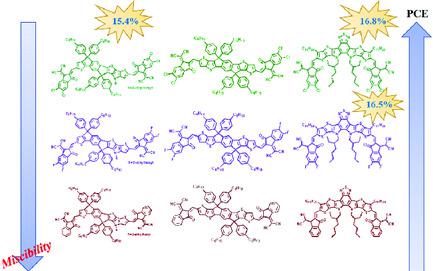Our official English website, www.x-mol.net, welcomes your
feedback! (Note: you will need to create a separate account there.)
Understanding the Effect of End Group Halogenation in Tuning Miscibility and Morphology of High‐Performance Small Molecular Acceptors
Solar RRL ( IF 6.0 ) Pub Date : 2020-07-01 , DOI: 10.1002/solr.202000250 Ruijie Ma 1, 2 , Gang Li 3 , Dandan Li 3 , Tao Liu 1, 2, 3 , Zhenghui Luo 1, 2 , Guangye Zhang 4 , Ming Zhang 5 , Zaiyu Wang 5 , Siwei Luo 1, 2 , Tao Yang 6 , Feng Liu 5 , He Yan 1, 2 , Bo Tang 3
Solar RRL ( IF 6.0 ) Pub Date : 2020-07-01 , DOI: 10.1002/solr.202000250 Ruijie Ma 1, 2 , Gang Li 3 , Dandan Li 3 , Tao Liu 1, 2, 3 , Zhenghui Luo 1, 2 , Guangye Zhang 4 , Ming Zhang 5 , Zaiyu Wang 5 , Siwei Luo 1, 2 , Tao Yang 6 , Feng Liu 5 , He Yan 1, 2 , Bo Tang 3
Affiliation

|
A multitude of studies have been conducted on organic solar cells (OSCs) to understand how end group halogenation changes the property of the small molecular acceptors (SMAs) energetically, morphologically, and so on. But how the halogenation impacts the miscibility between SMAs and polymers, which is an important index to thermodynamically predict and understand the morphology of blend films, has not been systematically studied, particularly for the state‐of‐the‐art polymer–SMA blends. Herein, three series of asymmetric or symmetric SMAs, all reported recently with high photovoltaic performances, are used to investigate the effect of halogenation on miscibility, crystallinity, and solar cell performance. Using the asymmetric SMA named TPIC, and its derivatives (TPIC‐4F and TPIC‐4Cl) as the focus, it is revealed that the enhancement in solar cell performance for the halogenated SMAs is to reduce the miscibility between the acceptor and donor, which leads to a more favorable morphology, enhanced charge transport, and an extended absorption range. Similarly, the halogenation‐induced reduction in miscibility for the initially overmixed donor:acceptor blend is also demonstrated in the symmetric ITIC and the state‐of‐the‐art BTP series, where attractive power conversion efficiencies (PCEs) of 16.5% and 16.8%, respectively, are achieved by the halogenated‐SMA‐based devices in each series.
中文翻译:

了解端基卤化对高性能小分子受体的溶混性和形态的影响
已经对有机太阳能电池(OSC)进行了大量研究,以了解端基卤化如何从能量,形态等方面改变小分子受体(SMA)的特性。但是,卤化如何影响SMA与聚合物之间的可混溶性,这是热力学预测和理解共混膜形态的重要指标,尚未系统地研究,特别是对于最新的聚合物-SMA共混物。本文中,最近报道了具有高光伏性能的三个系列的不对称或对称SMA,用于研究卤化对混溶性,结晶度和太阳能电池性能的影响。以名为TPIC的非对称SMA及其衍生物(TPIC-4F和TPIC-4Cl)为重点,据揭示,卤代SMA的太阳能电池性能的增强是减少受体与供体之间的可混溶性,这导致更有利的形态,增强的电荷传输和扩大的吸收范围。同样,在对称的ITIC和最新的BTP系列中,也证明了最初过度混合的供体:受体混合物因卤化而导致的混溶性降低,其有吸引力的功率转换效率(PCE)分别为16.5%和16.8%。分别通过每个系列中基于卤化SMA的设备实现。
更新日期:2020-07-01
中文翻译:

了解端基卤化对高性能小分子受体的溶混性和形态的影响
已经对有机太阳能电池(OSC)进行了大量研究,以了解端基卤化如何从能量,形态等方面改变小分子受体(SMA)的特性。但是,卤化如何影响SMA与聚合物之间的可混溶性,这是热力学预测和理解共混膜形态的重要指标,尚未系统地研究,特别是对于最新的聚合物-SMA共混物。本文中,最近报道了具有高光伏性能的三个系列的不对称或对称SMA,用于研究卤化对混溶性,结晶度和太阳能电池性能的影响。以名为TPIC的非对称SMA及其衍生物(TPIC-4F和TPIC-4Cl)为重点,据揭示,卤代SMA的太阳能电池性能的增强是减少受体与供体之间的可混溶性,这导致更有利的形态,增强的电荷传输和扩大的吸收范围。同样,在对称的ITIC和最新的BTP系列中,也证明了最初过度混合的供体:受体混合物因卤化而导致的混溶性降低,其有吸引力的功率转换效率(PCE)分别为16.5%和16.8%。分别通过每个系列中基于卤化SMA的设备实现。











































 京公网安备 11010802027423号
京公网安备 11010802027423号